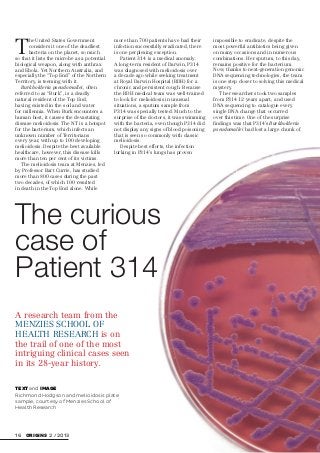Report
Share
Download to read offline

Recommended
Recommended
More Related Content
Featured
Featured (20)
Product Design Trends in 2024 | Teenage Engineerings

Product Design Trends in 2024 | Teenage Engineerings
How Race, Age and Gender Shape Attitudes Towards Mental Health

How Race, Age and Gender Shape Attitudes Towards Mental Health
AI Trends in Creative Operations 2024 by Artwork Flow.pdf

AI Trends in Creative Operations 2024 by Artwork Flow.pdf
Content Methodology: A Best Practices Report (Webinar)

Content Methodology: A Best Practices Report (Webinar)
How to Prepare For a Successful Job Search for 2024

How to Prepare For a Successful Job Search for 2024
Social Media Marketing Trends 2024 // The Global Indie Insights

Social Media Marketing Trends 2024 // The Global Indie Insights
Trends In Paid Search: Navigating The Digital Landscape In 2024

Trends In Paid Search: Navigating The Digital Landscape In 2024
5 Public speaking tips from TED - Visualized summary

5 Public speaking tips from TED - Visualized summary
Google's Just Not That Into You: Understanding Core Updates & Search Intent

Google's Just Not That Into You: Understanding Core Updates & Search Intent
The six step guide to practical project management

The six step guide to practical project management
Beginners Guide to TikTok for Search - Rachel Pearson - We are Tilt __ Bright...

Beginners Guide to TikTok for Search - Rachel Pearson - We are Tilt __ Bright...
Origins_Patient 314
- 1. 16 ORIGINS 2 / 2013 T he United States Government considers it one of the deadliest bacteria on the planet, so much so that it lists the microbe as a potential biological weapon, along with anthrax and Ebola. Yet Northern Australia, and especially the “Top End” of the Northern Territory, is teeming with it. Burkholderia pseudomallei, often referred to as “Burk”, is a deadly natural resident of the Top End, having existed in the soil and water for millennia. When Burk encounters a human host, it causes the devastating disease melioidosis. The NT is a hotspot for the bacterium, which infects an unknown number of Territorians every year, with up to 100 developing melioidosis. Despite the best available healthcare, however, this disease kills more than ten per cent of its victims. The melioidosis team at Menzies, led by Professor Bart Currie, has studied more than 800 cases during the past two decades, of which 100 resulted in death in the Top End alone. While more than 700 patients have had their infection successfully eradicated, there is one perplexing exception. Patient 314 is a medical anomaly. A long-term resident of Darwin, P314 was diagnosed with melioidosis over a decade ago while seeking treatment at Royal Darwin Hospital (RDH) for a chronic and persistent cough. Because the RDH medical team was well-trained to look for melioidosis in unusual situations, a sputum sample from P314 was specially tested. Much to the surprise of the doctors, it was swimming with the bacteria, even though P314 did not display any signs of blood poisoning that is seen so commonly with classic melioidosis. Despite best efforts, the infection lurking in P314’s lungs has proven impossible to eradicate, despite the most powerful antibiotics being given on many occasions and in numerous combinations. Her sputum, to this day, remains positive for the bacterium. Now, thanks to next-generation genomic DNA sequencing technologies, the team is one step closer to solving this medical mystery. The researchers took two samples from P314 12 years apart, and used DNA sequencing to catalogue every single DNA change that occurred over this time. One of the surprise findings was that P314’s Burkholderia pseudomallei had lost a large chunk of TEXT and IMAGE Richmond Hodgson and melioidosis plate sample, courtesy of Menzies School of Health Research A research team from the MENZIES SCHOOL OF HEALTH RESEARCH is on the trail of one of the most intriguing clinical cases seen in its 28-year history. The curious case of Patient 314
- 2. 17 ORIGINS 2 / 2013 its genetic code, or genome, in just 12 years. Four per cent of the genome, or 221 genes, were purged. Senior Menzies Research Officer and co-author of the study, Dr Erin Price offers a simple explanation for the change in genetic makeup: “The Burk residing in P314’s lung has developed an intimate relationship with its host, so it no longer needs those genes for environmental survival,” she said. “Several mutations were identified in genes involved in virulence and evasion of the human immune system. These extensive changes mean that a once-deadly organism has become irreversibly adapted to its human host, and would probably be unable to cause disease in another human being.” Collaborating Senior Menzies Research Officer and co- author Dr Derek Sarovich said that perhaps the most stunning finding was the possible cause for P314’s asymptomatic infection. “We identified a novel mutation in capsular polysaccharide, which is a protective casing surrounding the bacterium and an essential virulence determinant. Intact, this factor assists Burk in evading the human immune response early on, but might have a detrimental effect for bacterial survival in the human host over the long term,” he said. “Patient 314’s isolates had a unique mutation in this virulence factor, rendering it non- functional. So its loss of function early in the infection might explain why P314 did not exhibit classic melioidosis symptoms. “It was intriguing to watch the infection evolve over time to survive within the human lung without causing disease. There were quite dramatic, extensive changes, many more than we expected.” For the Menzies Meliodosis team, P314 has answered a lot of questions about how Burkholderia pseudomallei has become such a successful pathogen. Patient 314 represents a remarkable case that has helped the team to understand what genes are responsible for causing the disease in “normal” melioidosis cases, some of which have not been previously identified. Burkholderia pseudomallei colonies isolated from P314. Dr Derek Sarovich and Dr Erin Price. This disease kills more than 10 per cent of its victims.